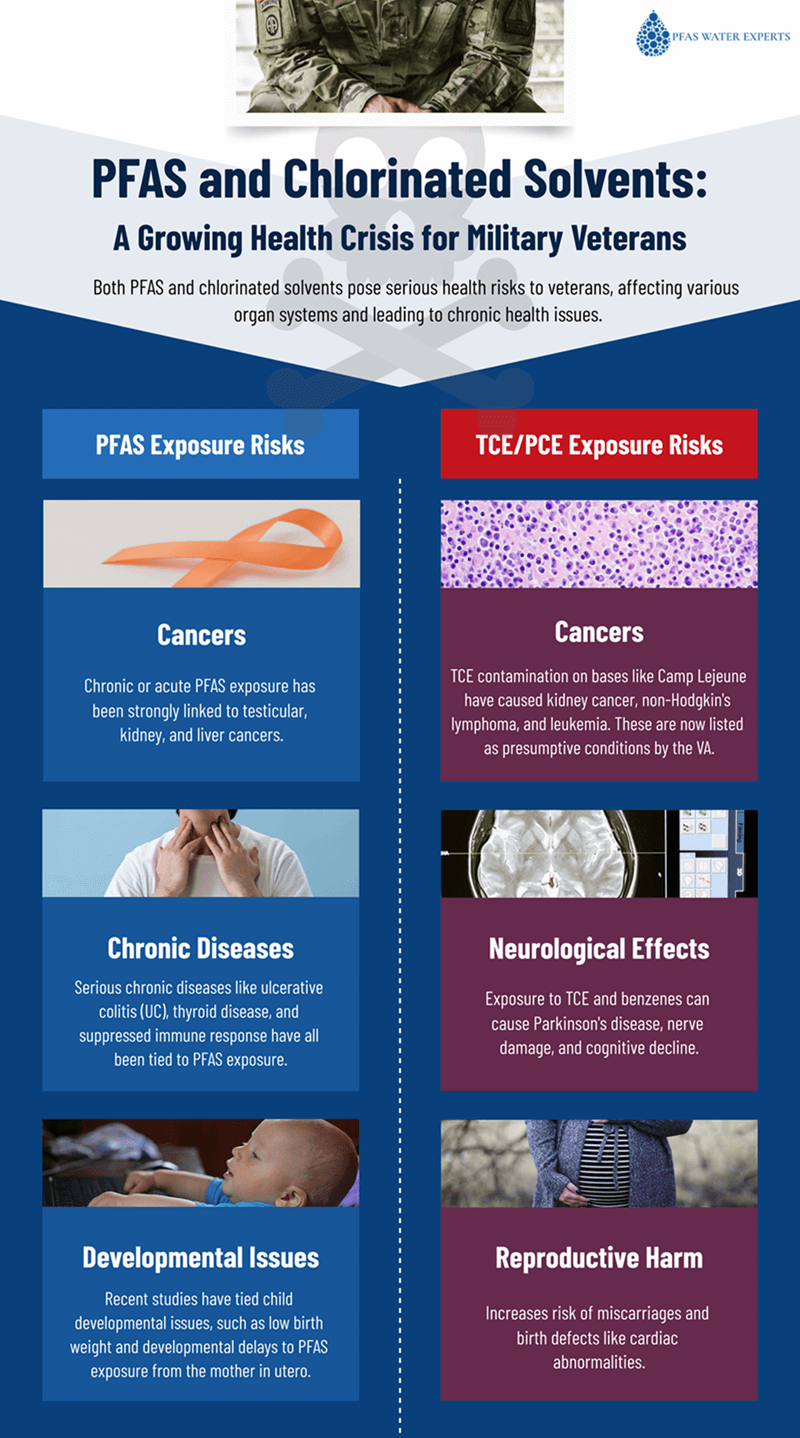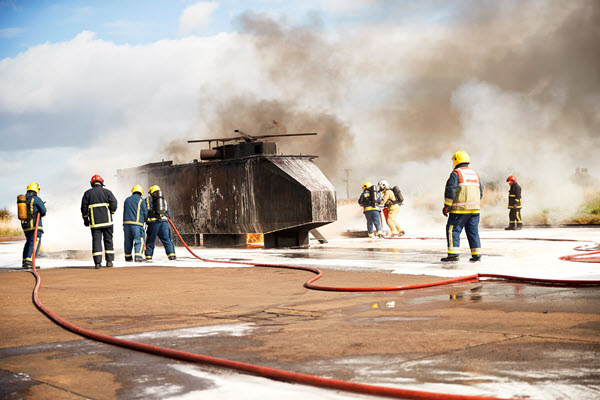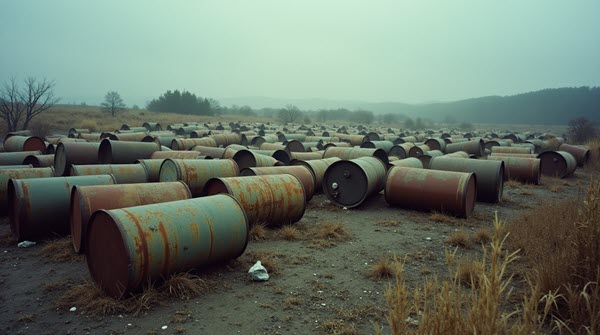Introduction
Military bases across the United States face widespread contamination from two particular groups of hazardous chemicals that are linked to severe health risks for service members, veterans, and their families: 1) PFAS (per- and polyfluoroalkyl substances) and 2) chlorinated solvents.
After more than 35 years of working as an environmental scientist focused primarily on hazardous waste investigations at military bases, industrial facilities and commercial properties I never thought I would see such a catastrophic new group of chemicals emerge, as has PFAS.
My hands-on experience locating and categorizing soil and water hazards at Massachusetts Military Reservation, Loring Air Force Base, Plattsburg Air Force Base, Ft Devens Army Installation and Brunswick Naval Air Station, among many others, prepared me to effectively perform environmental investigations but did not prepare me to deal with such pervasive and insidious chemicals such as PFAS.
PFAS, often called “forever chemicals” due to their persistence in the environment, have seeped into groundwater and drinking water supplies through decades of military operations.
In the rest of this article, I break down how this contamination occurred, its health impacts, and what’s being done to address it.
How Does PFAS Contamination Occur on Military Bases?
What are PFAS?
PFAS are synthetic chemicals used in firefighting foam (AFFF), nonstick cookware, and water-resistant materials. Their strong carbon-fluorine bonds make them nearly indestructible, allowing them to accumulate in soil, water, and human bodies over time.
Frequent AFFF Use and Runoff into Groundwater
Since the 1960s, the military, most commercial airports and fire departments have relied on aqueous film forming foam (AFFF) to extinguish fuel fires during training exercises and emergencies. Each use released high concentrations of PFAS into the environment, contaminating soil, surface waters, and groundwater.
Even though AFFF is also used by municipal fire departments to extinguish fuel fires, military bases suffer from much higher concentrations of PFAS contamination from AFFF for two reasons:
- Frequent AFFF use within a limited geographic area. Many military bases have airfields, ships, or equipment that are located within the same areas on base during training. Unlike civilian fires which can be spread out throughout a city, fuel fires on military bases generally occur in the same predictable areas where equipment is used to train.
- Self-contained, independent water treatment plants on base. All military bases have their own independent water treatment plants. They are designed this way on purpose so that they can independently sustain themselves; however, when runoff from AFFF contaminates base groundwater, this contaminated water is processed through the on-base water treatment plant. For decades, PFAS did not get filtered out of the contaminated water and was ingested by military servicemembers and their families.
Other Sources of PFAS Contamination
It is also important to recognize each of us has been using products and materials that contain PFAS. Our food containers, water repellent clothing, our laundry detergents, rug shampoos, pesticides, cosmetics, paint and photography materials, among many others.
Leaking underground storage tanks, landfills containing PFAS-laced waste, household septic tanks, wastewater treatment plants, and industrial waste discharges create many more sources to investigate and remediate.
Military personnel are unique in that they may be exposed during the work day using these materials and then spent the remaining hours in base housing and near the contaminated soil and drinking contaminated water.
Scale of PFAS Contamination on Military Bases
Over 700 U.S. military bases have confirmed PFAS contamination, with hundreds more under investigation.
For example, PFAS levels at sites like Fort Wainwright (Alaska) and Naval Station Newport (Rhode Island) far exceed the EPA’s safety limit of 4 parts per trillion (ppt).
Example Case Studies on Military Base PFAS Contamination
Wurtsmith Air Force Base, Michigan
PFAS contamination from AFFF use here led to groundwater levels of PFOS (a PFAS subtype) at over 100,000 ppt. That’s over 25,000 times the EPA’s limit of 4 ppt. Residents nearby face elevated rates of thyroid disease and breast cancer.
Pease Air Force Base, New Hampshire
PFAS contamination at the base is well-documented and is the result of firefighting AFFF use and industrial processes. Testing in 2014 revealed high levels of PFAS in the base drinking water.
Federal and State health studies were initiated and are still ongoing to better document and understand the correlation of community and base health impacts from PFAS exposure.
Adults and day-care children exposed to the drinking water have been found to have PFAS blood levels 2-3 times higher than most of the US population.
Chlorinated Solvents: Mishandling and Leaks on Bases
What are Chlorinated Solvents?
Chlorinated solvents, such as trichloroethylene (TCE) and tetrachloroethylene (PCE), are industrial degreasers used for cleaning machinery, weapons, and aircraft parts. These solvents easily evaporate into the air or seep into groundwater, where they can persist for decades.
Chlorinated solvents are another class of hazardous compounds found on military bases.
Cleaning, painting, and military equipment degreasing solvents like TCE were often dumped into unlined pits or stored in corroding tanks. TCE is also created by the natural degradation of PCE.
PCE has been used for over a century including widespread use in dry cleaning of clothes, paint stripping, metal degreasing, and petroleum refining.
We have identified PCE and TCE as hazardous chemicals and they are strictly regulated today. However, even with these regulations, widespread soil and water contamination persists.
How Veterans Were Exposed to Chlorinated Solvents
Service members handling solvents without protective gear risked inhaling vapors or absorbing chemicals through their skin.
But even families living on military bases were exposed through drinking base water that was contaminated by these toxic solvents.
Example Case Studies on TCE Contamination on Military Bases
Camp Lejeune, North Carolina (1953-1987)
At Camp Lejeune, North Carolina, TCE levels reached 1,400 parts per billion (ppb) – 280 times the EPA’s current limit-due to leaks from storage tanks. In fact, for over 30 years (1953 – 1987), Camp Lejeune’s water supply contained TCE, benzene, and other solvents.
Veterans and families who lived there report disproportionately high rates of cancers, Parkinson’s disease, and birth defects.
The VA now recognizes 15 presumptive conditions linked to this exposure, enabling affected individuals to claim benefits.
What About TCE Contamination on Other Military Bases?
While Camp Lejeune made headlines, it wasn’t the only base with TCE water contamination issues.
One of my first military base investigations, a large multi-service base in Massachusetts, revealed high levels of TCE in the groundwater used by the base and staff and in family housing. A warning was issued that all showering using base groundwater was to be severely limited. The use of hot water in a shower exposed individuals to a hazardous inhalation route besides skin absorption. The drinking water levels of TCE soon made groundwater treatment mandatory as well.
To this day, the real number of military bases with TCE water contamination is not entirely clear.
Cleanup Efforts and Challenges
PFAS Mitigation and Remediation
The Department of Defense (DOD) is transitioning to PFAS-free firefighting foams and installing groundwater filtration or destruction systems on affected bases.
However, we are finding that older PFAS foams are still in storage or even in an active mode that can spill at any time by accident.
A recent AFFF release at the former Brunswick Naval Air Base in Maine is a perfect example. The AFFF foam was not removed after base closure in 2009. In 2024, a hangar’s stored foam released accidentally running into streams and the soil and is now being found in the local groundwater.
There are also some challenging obstacles to overcome when it comes to PFAS remediation. PFAS cleanup is technically complex and very costly. Existing methods like carbon and other absorption chemicals are temporary but effective fixes, and we are just beginning to find possible technologies to fully destroy these chemicals and remove them from the environment.
Chlorinated Solvent Remediation
The EPA’s Superfund program has been using a variety of cleanup techniques for bases like Camp Lejeune, using methods such as soil vapor extraction and groundwater pumping.
These remediation efforts are limited, however, and complete removal is often impossible.
For example, at former George Air Force Base (California), TCE and jet fuel remain in groundwater — 25 years after cleanup began.
PFAS was also found in 2015 in the base’s groundwater making the cleanup even more difficult.
What Affected Veterans Can Do
- Medical Screening: Veterans exposed to PFAS or solvents should consult a VA Environmental Health Coordinator for free toxic exposure screenings.
- Compensation Claims: The VA offers disability benefits for conditions linked to military service exposures. For example, Camp Lejeune residents can file claims for covered illnesses.
- Legal Action: States and municipalities have filed lawsuits against PFAS manufacturers (e.g., 3M, DuPont) and have secured billions to fund city and municipal water cleanup and medical monitoring. Now, individuals can file personal injury claims against these same PFAS manufacturers if they become ill with certain cancers or other serious illnesses that have been linked to PFAS.
The Uncertain Road Ahead
While the DOD currently has committed $1-2 billion per year to address environmental restoration with a significant portion allocated for PFAS investigation and remediation at military bases, the current cleanup tools and techniques can easily exhaust this yearly amount unless we find more cost and technically effective processes.
DOD has acknowledged that Military Base chemical exposure and health impacts are significant but the actual health care costs to treat PFAS- and chlorinated solvent-related illnesses remain unquantifiable for the moment.
Written By:

Robert Burger
Scientific Contributor
Robert is a scientific author and reviewer at PFAS Water Experts. As a senior environmental scientist and owner of environmental technology firm, Ingenuityworx, he brings over 35 years of extensive expertise in environmental contamination assessment, including investigation techniques, on-site chemical analysis, and soil and water assessments. Robert also actively conducts research on the extent and problems of PFAS contamination from household products and disposal into septic fields.
Legal Review by:

Andrew J. Cobos
Lawyer and Legal Reviewer
Jump to a topic
- Introduction
- How Does PFAS Contamination Occur on Military Bases?
- Example Case Studies on Military Base PFAS Contamination
- Chlorinated Solvents: Mishandling and Leaks on Bases
- Example Case Studies on TCE Contamination on Military Bases
- Cleanup Efforts and Challenges
- What Affected Veterans Can Do
- The Uncertain Road Ahead











